-
If you are citizen of an European Union member nation, you may not use this service unless you are at least 16 years old.
-
You already know Dokkio is an AI-powered assistant to organize & manage your digital files & messages. Very soon, Dokkio will support Outlook as well as One Drive. Check it out today!
| |
Cosplay
Page history
last edited
by Madeline Parrish 13 years, 7 months ago
[Image heavy warning]
What is Cosplay?
Cosplay is, on a basic level, just what it sounds like: dressing in a costume to present before others for various reasons. More specifically, cosplay is the art of creating and presenting an often elaborate costume based on a specific anime or game character, but are not limited to that. Honestly, if you can imagine it, there is cosplay of it.
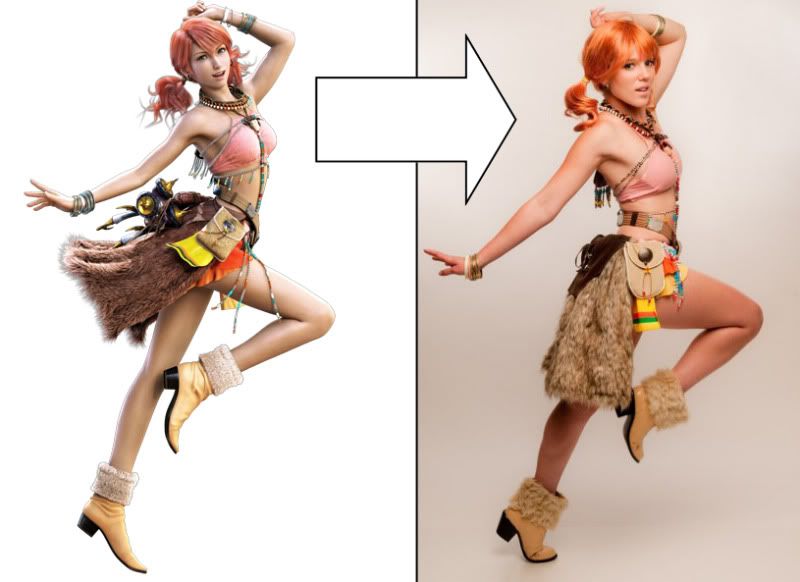
( This is cosplay done right. Don't get used to it -- far more people do it wrong )
Anime Cosplay
Anime cosplay is easily the most common type of cosplay, given the surge in popularity of anime and manga in the last decade. Manga characters gets lumped into the "anime cosplay" partially due to the symbiotic nature of the mediums of sharing series but mostly because they have more in common than the other classifications. Listed below are some of the divisions of the anime cosplay hierarchy and basic descriptions (which will be done for each category).
- Axis Powers Hetalia: So maybe you scoffed at the idea of anything you can imagine being cosplayed. Luckily, Axis Powers Hetalia comes along to ruin your perceptions as all the characters of the series are personified countries. The series is relatively new but has a cult following and is widely cosplayed now with many of the characters carrying their respective flags as a hint to who (or what) they are supposed to be. At least now we can all rest easy knowing another of life's toughest questions has been answered: Hungary is indeed a cute little girl.

(Ironicly, Hungary is not pictured here. The Holy Roman Empire is, however.)
- Mechs: Ok, personified countries you can imagine. But surely no one is crazy enough to cosplay one of those giant mechs from animes like Gundam or Gurren Lagann. Clearly you underestimate the determination of an adamant cosplayer. While mech cosplays are not common they do exist and for the most part are purely awesome. While most cosplay requires sewing and basic crafting skills these cosplays require extreme building skills to: fit, be mobil, and look good. I look at a schematic for one of these suits and it was far beyond my comprehension so I give props to those who can pull it off successfully.

(Yeah, that's really a costume. A huge one, at that.)
- "Stereotypical" Cosplay: These are your standard sailor fuku (school girl), catgirl, maid, and nurses cosplays (to name a few) that stem from the frequent occurance of these characters in anime and may even draw influence from specific characters but are generalized (and overdone). All the of the aforementioned costumes have also been highly fetishised and are regarded generally as sex symbols.
(Use your imagination for this one.)
Video Game Cosplay
Next comes the video game cosplay category. As a general rule, if a character or series has been both an anime and video game you generally base whether you are an anime or video game cosplayer based on which of the outlets you take your costume from or which is more prominent; ie, Pokemon would classify as video game as it debuted as such, unless the character is only in the anime. On the topic of Pokemon, cosplayers get very creative with costumes, creating the first of the video game subcategories, Pokemon Gijinka.
- Pokemon Gijinka: This label exists for for costumes of pokemon translated into a human form. Gijinka became incredibly popular, both because it allowed great creativity in the designs and because it allowed cosplaying as one's favourite Pokemon without wearing a giant furry suit. Still, many video-game cosplayers will forsake personal comfort for the benefit of fandoms so costumes such as Tetris blocks are not uncommon.
 
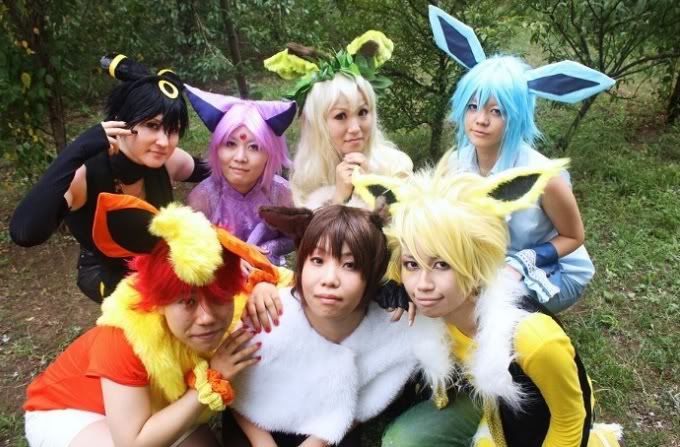 (If you can name all the Pokemon present without a reference, (If you can name all the Pokemon present without a reference,
you probably need to get out more.)
- MMO Characters: Anyone who has ever played an MMO (a Massively Multiplayer Online game) with any character customization is bound to understand the feeling of pride one has over their own created character. It only makes sense that people would want to in turn cosplay as these characters to show off their epic gear you probably don't really have but who's going to know. Important NPCs of MMOs are also cosplayed on occasion.
 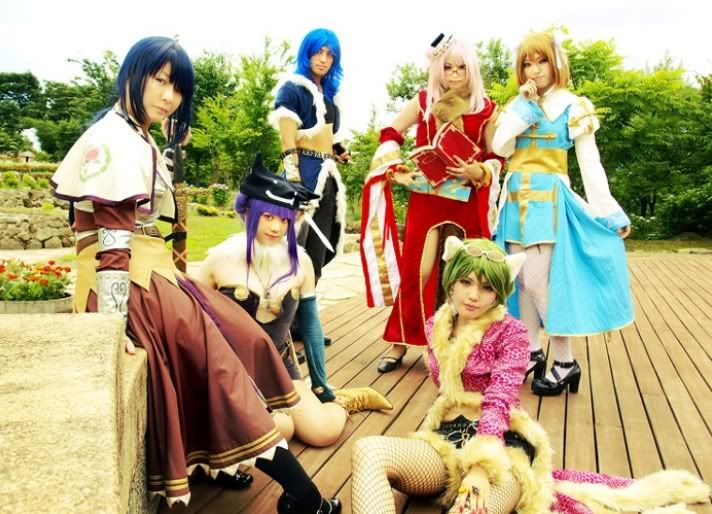
(I bet you were expecting a WoW cosplay.)
- Items, Monsters, Miscellaneous: You have to respect the creativity of some of these cosplayers. I've seen peopled dressed as game save points, cardboard boxes, companion cubes, humanized video game consoles, obnoxious sidekick fairies, and every bizarre kind of monster or summon creature. These cosplayers serve as props to be used or posed with by other characters from the same game, while drawing their own attention for uniqueness.

(No criticism available. Just awe.)
Cultural Cosplay
Moving away from fantasy we come to cultural cosplay where individuals don all sorts of "Japanese" clothing. This ranges from ancient ethnic dress to the popular fashions of the time, which is arguably not always Japanese but often has a Japanese take of it.
- Samurai, Ninjas, Priests, oh my: Many animes and video games incorporate elements of Japanese history (and I use that term loosely) and due to the success of a certain blonde-haired, orange-jumpsuit-wearing-ninja, cosplaying characters from history has become popular. The most widely cosplayed are ninjas, samurai, and Shinto or Buddhist priests. All three occur frequently in the media and have developed their own fairy-tales that elevate them to the height of super humans. Well, except maybe the priests. But they're popular in anime, so they get a following that way.
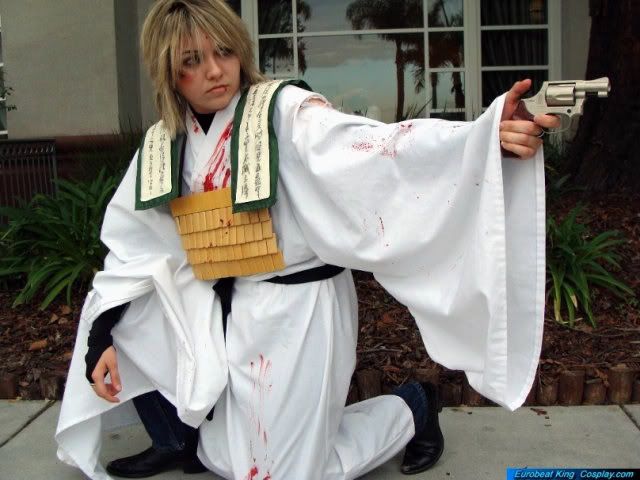
(Strange... I didn't think monks used guns. Or participated in combat.)
- Kimonos, Yukatas, Wa-loli: Ethnic dress is commonly used in authentically Japanese anime as a way of incorporating the culture and allowing the (Japanese) readers to relate to the characters when they attend festivals or other such events. It should also be noted that kimonos and yukatas are still worn in Japan as everyday attire by some and is far from being considered out of place. As a result, the creative fashion minds of Japan gave the kimono new life in the wa-loli style, a kind of mix between Kimonos and Sweet Lolita (I'll cover that next). Kimonos are shortened to about knee-length typically and garnished with bows, ribbons, lace, corsets, whatever the maker deems fashionable and gives off an air of cuteness.

(That was once a kimono)
- Lolita Styles: So, after my wa-loli teaser I'm sure you want to know just what this "lolita" nonsense is. Lolita is a fashion trend birthed out of Harajuku station that has three forms; sweet lolita, gothic lolita, and punk lolita. Sweet and gothic lolita are almost identical except for color schemes. They focus on exagerated baby-doll type dresses with ruffles, frills, and oversized bows. As you may have guessed, sweet lolitas use pastel colors of blue, pink, and whites mixed with cute fruit patterns while gothic lolitas stick to black and white in a more refined look. Punk lolita is the black sheep of the group, focusing on chains, rips, pins, and a liberal use of engrish. I've read many books on lolitas and I'm honestly still not sure why punk lolitas are categorized with the others but fashion needs no explanation, right? Regardless, publications like "The Gothic and Lolita Bible" (now in English!) have helped spread this trend far beyond harajuku station and reaching as far as South America and Russia.
 
(...One of these things is not like the other~)
- Harajuku Styles: By now you're probably reeling from all this new information but feeling fairly certain you've witnessed the weirdest things I can come up with. Haha, you poor misinformed soul, I haven't even gotten to the deviants section. On that note, Harajuku styles defines the fashions that have born out of Harajuku Station and surrounding area in Japan. On Sundays, Harajuku station will be populated by individuals wearing all manner of fashion from the extremely-cute-to-the-point-of-inducing-seizure to the rough and fierce looking visual-kei (a punk fashion based around music) and everything in between. And yes, I mean everything. Trying to explain this one isn't going to do any good, so here are some pictures.
 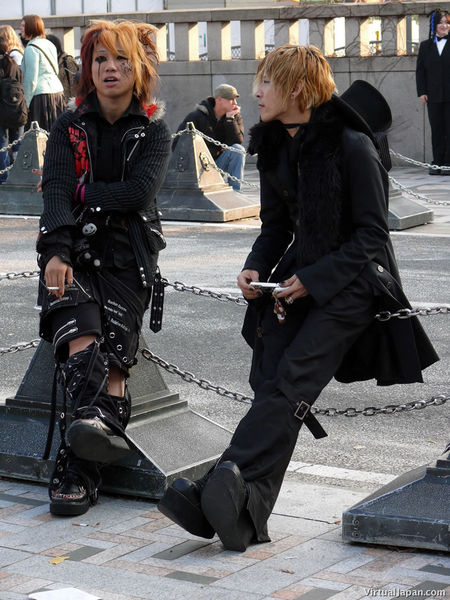 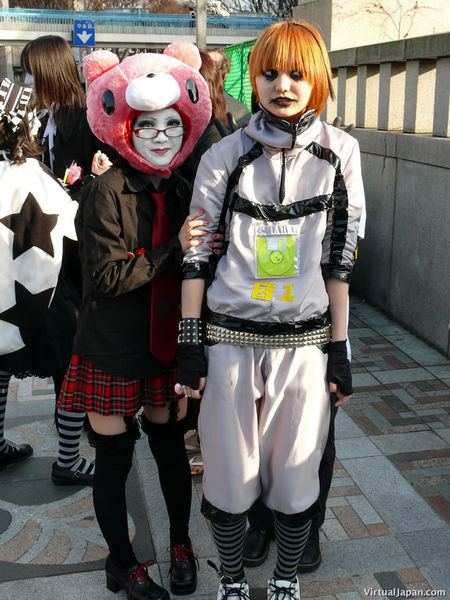
(Lady Gaga would be proud.)
Deviants of Cosplay
I apologize in advance for what will follow.
- Pop Culture & The Internet: So, as some of you are probably aware, the internet has it's own icons and celebrities, many of whom are represented at anime conventions worldwide. But wait, some of you are saying that shouldn't count as cosplay! What exactly is and is not cosplay is a very gray area and generally as long as it is represented at an anime focused event (or in Japan) it counts as cosplay. That rule applies for pop culture persona's as well so, yes, that zombie Michael Jackson you saw running around Animazement was a cosplay, not just a person in a suit.

- Animegao ("Dollers'): Animegao (nicknamed "Dollers") are basically regular cosplayers. Except that they anime masks with the misshapen stylized features of the original anime character art. Fortunantly, these cosplayers are very rare. They are also creepy.

(...shudder.)
- Crossplay, Yaoi, Yuri: So, on occasion you might spot an incredibly beautiful cosplayer and on a closer observation discover that the "pretty girl" you were admiring is in fact a male. This is called crossplay and yes it goes both directions. Females dressing as male characters is incredibly common and often well done. However, males dressing as females tend to be rarer due to the revealing nature of female costumes and are often parodied because of this (and for shock value). Two of the most famous shock-value crossplayers are "man-Faye" and "man-Sailor Moon", the latter being shown below. With gender roles already being skewed, cosplay also serves as fanservice for fans of homosexual couplings, malexmale (yaoi) and femalexfemale (yuri). Often these couplings are based on fan interest only but some are from actual yaoi and yuri animes.
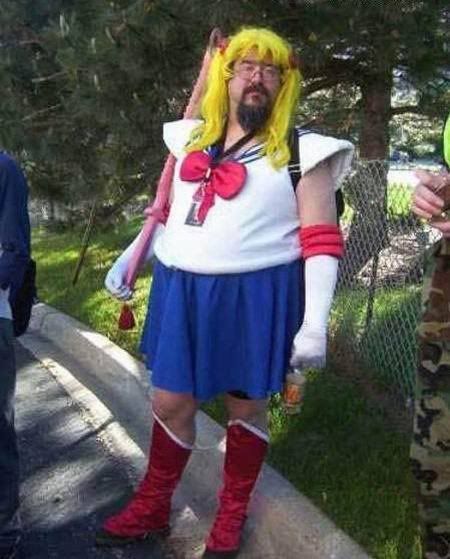 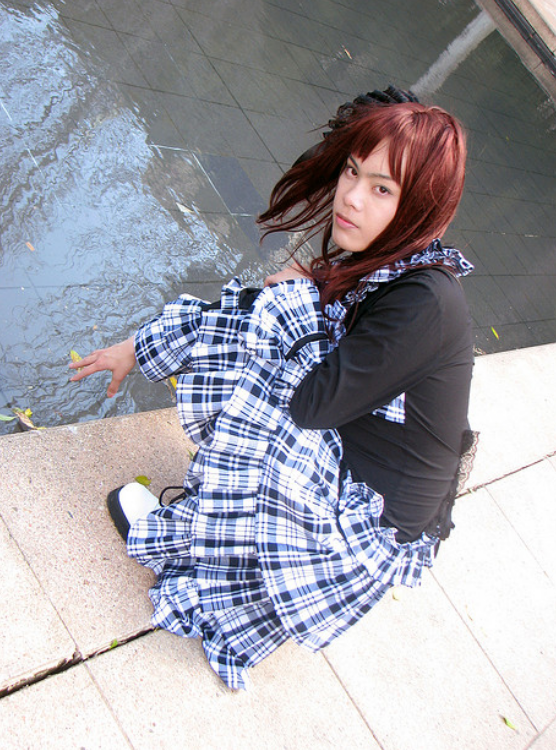
(Lets play a game! What gender are the people above?)
- Furries: The term "furry" denotes individuals who dress in entire fur suits to accurately portray an animalistic character. The fur suits cannot be bought normally and require an extreme amount of dedication and work making furry cosplayers relatively uncommon. Unfortunantly, the term "furry" has grown to have a negative connotations and as a result these cosplayers are often looked down on.
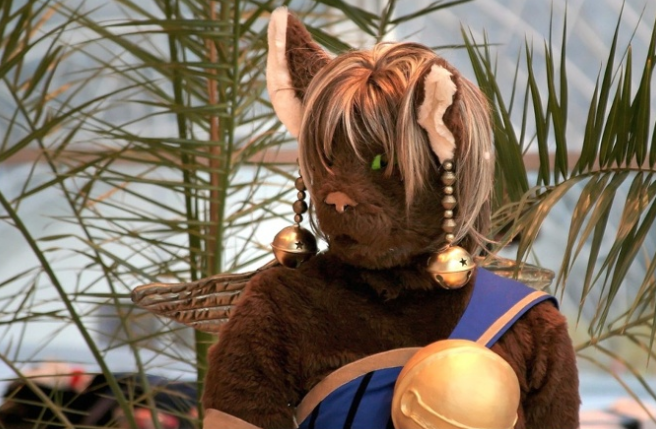
(She's looking at you.)
Where do you find cosplay?
Now that you are completely overwhelmed by the variety and bizareness of cosplay you might be wondering where on earth these people get together to run amuk in costumes. For Americans, the short answer is anime conventions. The longer answer includes photoshoots for professional photographers, lolita tea parties, and bouts of LARPing. Often, a photographer trying to make a name for himself or in need of more material will attend anime conventions or arrange private photo shoots with cosplayers. This serves both parties as the cosplayer gets to display their costume and become known by the viewers of the photographer and the photographer gets a free model in unique clothing to shoot to build his portfolio in addition to spreading his name and fanbase.
In Japan, cosplayers have a bit more notoriety. As comics and anime are a widely consumed part of the culture cosplayers can serve as advertisement for the distributors. Professional cosplayers (yes they're real) are widely sought for promotion campaigns in addition as fashion icons and get paid roughly $150 an hour for their services. Cosplayers are also found in special cosplay themed cafes and libraries where they act as hostess' to the guests. As you may have guessed cosplay has also become fetishized and there are specialized cosplay groups (often found on the internet) that cater to this market. And that's all I'm saying on the matter.
But, why?
But why, you ask, why devote all this time and money into an activity that in America you can only display a few times a year, and that's if you're willing to travel? Because it's fun. Think back to your childhood and the excitement you had when your mummy got you that batman suit all the kids were talking about and you proudly ran around on Halloween pretending to be batman. It's like that. In addition, cosplay also serves as a social group that allows people of similar interests to meet and communicate often resulting in friendships. Finally, what's more American than the time honored tradition of escapism. For a day you are able to pretend to be someone completely different and instantly interact with people of the same series without any introduction necissary. In addition, there is the added perk of fanservice where true fans (or fanatics) of series can request or take part in scenes or couplings not in the canon. In essence, cosplay is a return to childhood escapist antics based around a more mature content that many cosplayers can find a guilty pleasure in.
How do you cosplay?
- Research: First, you need to pick a character to cosplay. Some things to bear in mind during this process include hair color (will you need a wig?), the costume (can it be altered from everyday clothes or entirely custom made?), practicality (would I be comfortable wearing this costume in public all day?), etc. Once your decision is made, determine how much you are willing to spend; trust me, fabric gets pricey.
- Materials: Now you get to go from clothing store to fabric store, depending on your costume, looking for either clothes to alter (i.e., a Lara Croft kind of costume) or sewing patterns and material (i.e., almost anything else). Be sure to note all the materials you'll need in your original venture out so you can get an idea on how much the materials will cost you. It's easier to rack up a bigger bill if you make several small trips.
- Sew, sew, and try on!: Go into your basement, chain yourself to a sewing machine and begin working. I'd recomend doing a test of any new patterns you get before using your nice qualilty, expensive material. Muslin is a cheap fabric that is good for such tests. Once you get each part of your costume complete, try it on! See if you need to make any alterations before you go to the trouble of adding all the little details.
- Details: Go nuts.
- Accessories: Now that your costume is perfect you get to add on all the accessories to make it a perfect costume. Shoes, hair, and hand-held props are these sort of things that (generally) aren't necissary for the costume but add the extra push towards making your costume better than the rest.
- Debut: After all your hard work and slaving it's time to show it off! Have fun! : ]
Want to learn more?
Cosplay Galleries:
-Cosplay.com
-Cosplay Cure
-American Cosplay Paradise
Professional Cosplayers:
-Cosmode - Magazine of professional cosplayers
-Cosplay Idols - Short article on professionals
-Pinero Photography - Gallery of a professional photographer who shoots cosplayers
Cosplay Vendors:
-Cosplay House
-Cosplay Magic
-CosplayFU
-Epic Cosplay - Cosplay wig vendor
Fashion Cosplay Literature:
-Gothic and Lolita Bible (Link for the Tokyopop Page)
-Gothic and Lolita by Masayuki Yoshinaga & Katsuhiko Ishikawa
-Japanese Schoolgirl Inferno by Izumi Eevers & Patrick Macias
-Style Deficit Disorder: Harajuku Street Fashion by Tiffany Godoy
Cosplay
|
|
Tip: To turn text into a link, highlight the text, then click on a page or file from the list above.
|
|
|
|
|
Comments (0)
You don't have permission to comment on this page.